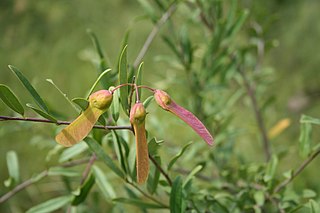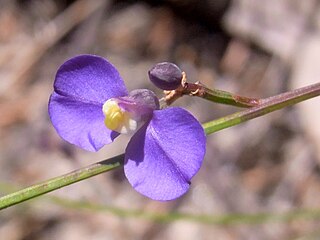
The Polygalaceae or the milkwort family are made up of flowering plants in the order Fabales. They have a near-cosmopolitan range, with about 27 genera and ca. 900 known species of herbs, shrubs and trees. Over half of the species are in one genus, Polygala, the milkworts.

Leucopogon is a genus of about 150-160 species of shrubs or small trees in the family Ericaceae, in the section of that family formerly treated as the separate family Epacridaceae. They are native to Australia, New Zealand, New Caledonia, the western Pacific Islands and Malaysia, with the greatest species diversity in the south-west of Western Australia. Plants in this genus have leaves with a few more or less parallel veins, and tube-shaped flowers usually with a white beard inside.

Pomaderris is a genus of about 80 species of flowering plants in the family Rhamnaceae, the species native to Australia and/or New Zealand. Plants in the genus Pomaderris are usually shrubs, sometimes small trees with simple leaves arranged alternately along the branches and bisexual, woolly-hairy flowers arranged in racemes or panicles. The flowers are usually yellow and often lack petals.

Actinotus is a genus of flowering plants in the family Apiaceae, subfamily Mackinlayoideae, with about 18 species. It is native to Australasia. Its best known member is the flannel flower, a common sight in Sydney bushland in the spring. The generic name, meaning "furnished with rays" is derived from the Greek stem aktin-/ακτιν- "ray" or "sunbeam".

Podolepis is a genus of flowering plants in the tribe Gnaphalieae within the family Asteraceae. It is endemic to Australia and can be found in every state.

Calothamnus is a genus of shrubs in the family Myrtaceae and is endemic to the south-west of Western Australia. The common names one-sided bottlebrush or claw flower are given to some species due to their having the flowers clustered on one side of the stem or because of the claw-like appearance of their flowers. Calothamnus species are generally medium to tall woody shrubs with crowded leaves. In most species the leaves are crowded and linear in shape, and the flowers are usually arranged in dense clusters. The petals are small and fall off the flower soon after it opens but the stamens are long, numerous and usually bright red.

Anthocercis, commonly known as tailflower, is a genus of shrubs which are endemic to southern temperate Australia with the center of distribution in the South West Botanical Province of Western Australia. All species of Anthocercis contain tropane alkaloids, and have occasionally caused poisoning in children or been suspected of poisoning stock. Anthocercis is known as the only Solanaceous plant known to produce resin compounds on glandular trichomes.

Calytrix is a genus of shrubs in the family Myrtaceae described as a genus in 1806. They are commonly known as starflowers. Calytrix are endemic to Australia, occurring in the.

Hemigenia is a genus of flowering plants in the mint family, Lamiaceae and is endemic to Australia where most species occur in Western Australia, although some are also found in New South Wales and Queensland. Plants in this genus are shrubs or bushes with simple leaves and tube-shaped flowers with the petals forming two "lips" - the upper one with two lobes and the lower one with three.

Brachyscome ciliaris, commonly known as variable daisy, is a small bushy perennial herb with a prominent flower, which occurs throughout most of temperate Australia

Comesperma ericinum, commonly known as heath milkwort, pink matchheads or pyramid flower, is a slender shrub of the family Polygalaceae. It grows to between 1 and 1.5 metres high and branches out vertically. The leaves are 5 to 25 mm long and 1 to 4 mm wide. Purple, lilac-pink or white "winged" flowers are produced in clusters at the end of the stems from October to January.

Siloxerus is a genus of Australian plants in the tribe Gnaphalieae within the family Asteraceae.

Comesperma volubile, commonly known as love creeper, is a slender climber in the family Polygalaceae. It is a twining plant with linear leaves and pea-like blue flowers.

Comesperma sphaerocarpum, commonly known as the broom milkwort, is an Australian plant in the milkwort family. Inconspicuous unless in flower, it grows from 10 to 30 cm high. The stems are ridged and usually leafless, and arise from the plant's woody base. The rarely seen leaves are at the base of the shoot. They are thick in texture, and measure 8 mm long by 2 mm wide. This plant first appeared in scientific literature in Plantae Preissianae in 1846, authored by the German botanist Joachim Steetz.

Pileanthus is a genus of flowering plants in the family Myrtaceae, endemic to Western Australia. Collectively referred to by the common name coppercups, the eight currently recognised species are:
Coelospermum is a genus of flowering plants in the family Rubiaceae. The natural range of the genus is parts of southern China, Malesia, Papuasia, Australia and New Caledonia.

Comesperma calymega, commonly known as blue-spike milkwort, is a slender herb in the family Polygalaceae. It is a perennial herb growing to between 10 cm and 50 cm high, from a short woody rhizome.

Comesperma drummondii, commonly known as Drummond's milkwort, is a slender herb in the family Polygalaceae. It is a perennial herb growing to between 20 cm and 1.2 m high, on sandy and gravelly soils Its pink-blue-purple flowers may be seen from August to November.

Comesperma virgatum, commonly known as milkwort, is a herb in the family Polygalaceae. It is an erect slender herb growing to between 30 cm and 1.6 m high, on sandy and lateritic soils, and sometimes in swampy conditions. Its pink to purple flowers may be seen from September to December or January to March.

Comesperma retusum, commonly known as milkwort, is a slender herb in the family Polygalaceae. It is an upright shrub with purple or mauve-pink pea-like flowers and grows in eastern Australia.



















